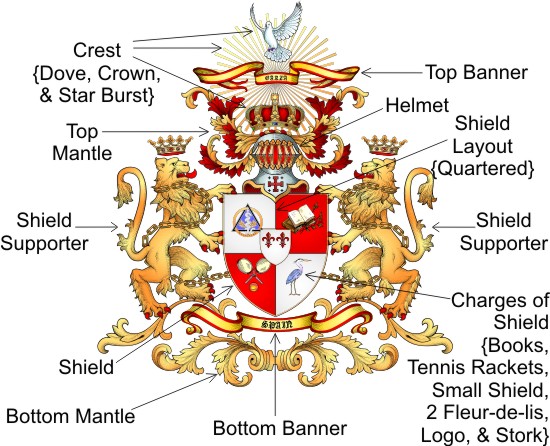Mrs. Johnston's Medieval History Blog 2012-13
Raise your sword in salute to the young historians at work here!
Thursday, April 25, 2013
A Famous Cookbook From the Middle Ages!
Labels:
Exit ticket #18,
King Richard II,
king's cookbook,
Medieval Studies 2012-13,
primary sources,
the Frome of Cury
Friday, April 12, 2013
Time to review what you know about becoming a member of a medieval guild!
You have been working on your Medieval Banquet and Faire projects for several weeks. Hopefully you've learned a lot about how a person in the Middle Ages would become a member of a craft or merchant guild. So, it is time for you to do a quick review of this process!
- Go to this web site and read about guilds. http://www.ducksters.com/history/middle_ages_guilds.php
- Go to this second web page and take the quiz. Make sure you click DONE at the bottom of the quiz and then wait for your score. http://www.ducksters.com/history/middle_ages_guilds_questions.php
- Finally, do the exit ticket.
This whole process shouldn't take you very long...maybe 15 minutes!
The pictures below show various medieval guilds
.


Thursday, April 4, 2013
Musicians in the Middle Ages
The life of a musician (also called a minstral) in the middle ages was generally seen as a desirable one. Minstrals might wander from town to town, playing at village squares or in ale houses, or they might be employed by a wealthy or royal family to play at a lord's feast or at a gathering at the royal court. Minstrals told stories through song, the most popular stories and tales being related to romance or the life of a knight. When traveling, minstrals might use light weight instruments like a fiddle or lute. If employed by a wealthy household or at the royal court, a musician might play heavier instruments like a tabor, clarion, or even bagpipes.
One interesting instrument from the middle ages is the hurdy gurdy.
How to play a Hurdy Gurdy from English Heritage on Vimeo.
You can see more pictures of this instrument and listen to some audio clips at this web site: http://www.music.iastate.edu/antiqua/hurdy.htm
One interesting instrument from the middle ages is the hurdy gurdy.
How to play a Hurdy Gurdy from English Heritage on Vimeo.
You can see more pictures of this instrument and listen to some audio clips at this web site: http://www.music.iastate.edu/antiqua/hurdy.htm
Sunday, March 17, 2013
Medieval Market Then and Now!

There is an interesting town in England called Norwich. It was once a Saxon town and a thriving trade center. It became a Norman town under William the Conqueror and he founded a castle there between 1066 and 1075. Interestingly, the market still exists in Norwich today, and there are over 190 stalls with people selling all sorts of things from food to clothing and more! Here is a link to an interactive map of what the market place looked like in the year 1300 and what sorts of things people were selling: http://www.norwich-market.org.uk/Medieval/wares.shtm . Roll your cursor over the pictures bordering the map for more information! Here is a link to what the market looks like today: market.org.uk/stalls/stalls_videos_WMV/stalls_WMV.shtm Roll your cursor over the numbers on the booths for information about what is being sold there today!
Thursday, March 7, 2013
Medieval Guilds and Trade Fairs
 The Crusades focused people's attention on religion, but they ended up having a powerful impact on Medieval Life in another way. They helped introduce people in Europe to new products from other countries, like spices, scented soaps, colorful rugs, and more. As people wanted to have these and other products, new trade routes opened and people from many countries began transporting their goods by land and by sea. Along some of the main routes, trade fairs were set up so merchants could sell their goods. Go to this web site and read more: http://medievaleurope.mrdonn.org/tradefairs.html.
The Crusades focused people's attention on religion, but they ended up having a powerful impact on Medieval Life in another way. They helped introduce people in Europe to new products from other countries, like spices, scented soaps, colorful rugs, and more. As people wanted to have these and other products, new trade routes opened and people from many countries began transporting their goods by land and by sea. Along some of the main routes, trade fairs were set up so merchants could sell their goods. Go to this web site and read more: http://medievaleurope.mrdonn.org/tradefairs.html.Thursday, February 28, 2013
Medieval Guilds

 Knights and nobles weren't the only ones who used coats-of-arms. Medieval Guilds would often display a coat-of-arms in their guild hall. A guild was a group of skilled craftsmen who did the same job. So, a group of shoemakers living in the same town would have formed a guild to make sure shoes were made to a certain standard of quality, to make sure that they sold for a fair price, and to make sure that their members had specific skills. To become a guildsman, a person had to go through three steps: apprentice, journeyman, and finally, a master. The two shields above represent the blacksmith guild and the shoemaker guild.
Knights and nobles weren't the only ones who used coats-of-arms. Medieval Guilds would often display a coat-of-arms in their guild hall. A guild was a group of skilled craftsmen who did the same job. So, a group of shoemakers living in the same town would have formed a guild to make sure shoes were made to a certain standard of quality, to make sure that they sold for a fair price, and to make sure that their members had specific skills. To become a guildsman, a person had to go through three steps: apprentice, journeyman, and finally, a master. The two shields above represent the blacksmith guild and the shoemaker guild.
Tuesday, February 19, 2013
Heraldry in American History.

The Arms of George Washington, 1st President of the United States. His shield appears on the Purple Heart as seen below. The original Purple Heart was established by George Washington as a Badge of Military Merit when he was Commander-in-chief of the Continental Army, 1782. Today it is a United States military decoration awarded by the President to those who have been wounded or killed while in service since April 5, 1917.

Modern Day Heraldic Artist works magic!
The art of heraldry is practiced today. Andrew Stewart Jamieson creates magnificent coats-of-arms. See the video below.
Thursday, February 14, 2013
Heralds record Coats-of-Arms in books called Rolls of Arms

The above picture is of a page from the Hyghalmen Roll, Germany, dating back to 1485.
Labels:
Coat-of-Arms,
Exit Ticket #13,
Heraldry,
Medieval Studies 2012-13,
primary sources,
Roll of Arms
Thursday, February 7, 2013
The Science of Heraldry
Heraldry, a system of using a variety of shapes and symbols on a shield or coat of arms to identify an individual or family, is almost 900 years old. The use of symbols on shields can be seen in the Bayeux Tapestry, a tapestry which we studied earlier this year and which is thought to have been made in the 1070's. It became a herald's job to create and keep records of the symbols and coats of arms. Go to the web site for the International Heraldry & Heralds to learn more and see amazing images:
http://www.internationalheraldry.com/
Below is a full achievement of arms
To play a heraldry game requiring skill, Click Here! To create a shield online, Click Here!
Labels:
Exit Ticket #12,
Heraldry,
Medieval Studies 2012-13
Friday, February 1, 2013
Enjoy Our Illuminated Manuscripts!
Medieval
Research and Manuscript Assignment
Ye shall research your assigned topic: Book of
Hours.
Your final product will consist of the following:
An illuminated manuscript written in calligraphy
on parchment.
It should include the following:
- An illuminated letter
- A rubric…in Latin using calligraphy printing
- A historiated letter
- An inhabited margin
- A miniature painting
- Text: should be a prayer, poem, etc. that you might
recite at one of the eight times for prayer in your short version of a Book of Hours.
Thursday, January 24, 2013
A 21st Century Illuminator creates a 21st Century Illuminated Manuscript!
Calligraphers and illumination artists were jobs in the middle ages. However, they are also jobs in the 21st century! In 1998 a group of people at St. John's Abby and University met with master calligrapher Donald Jackson to start a project to create the first handwritten bible since the invention of the printing press! The bible is called The St. John's Bible. It is seven volumes, each 2 feet tall, and 3 feet wide when opened! It is made of vellum, has about 160 illuminations, and cost about $8 million dollars to produce!
To learn a little more about this modern day illuminated manuscript, go to this web page and click on Layout & Design and Tools and Materials.
Click Here!
Young historians just like you study the art of illuminating letters! Below is a video of illuminated letter artwork created by elementary students.
Thursday, January 17, 2013
What is the Book of Kells?
There are some wonderful illuminated manuscripts that have survived the test of time! Click Here!
Tuesday, January 15, 2013
The Making of an Illuminated Manuscript
Thursday, January 10, 2013
Monks preserve history in illuminated manuscripts.
As you listen to the lyrics of the song sung on this video, you will hear a variety of the materials used to make the illuminations. Enjoy!
There were many steps necessary to make an illuminated manuscript, and a number of people were involved in the process. Go to this web site to find out more. Click Here!!!
Thursday, December 13, 2012
A Squire has much to learn before becoming a knight!
When a knight practiced, prepared for battle, or went to compete in a tournament, his squire would go with him. Can you tell what some of his duties might be after watching these two videos?
Labels:
Exit Ticket #8,
knights,
Medieval Studies 2012-13,
squires
Thursday, December 6, 2012
The Life of a Medieval Knight
Three groups of fighting men were important in the middle ages: foot soldiers, archers, and knights. The knight who visited us on the first day of school this year, Sir Karl Kindt, gave us an introduction to what it meant to be a knight in the middle ages. It is time to learn more about knights, so check out these web sites:
The Medieval Knight:
http://library.thinkquest.org/10949/fief/medknight.html#become
Sir Karl Kindt, Knight for Hire:
http://www.knightforhire.com/

Illustration of a knight (ca. 1250 C.E.) thought by some to represent
King Henry III of England...image on this web site: http://www.knightsandarmor.com/
Labels:
knights,
Medieval Studies 2012-13
Thursday, November 29, 2012
King Edward I and his castles in Wales
As history detectives, it is only natural that we would be curious about how people, places and things actually looked in long ago. For times before photography, we must rely on sketches, paintings, and other forms of artwork produced during the period we are studying. Below are two images of King Edward I, the English king who invaded Wales and strengthened his powerful hold over the country by building incredible castles and walled towns. Here are two images of Edward. The first is from a medieval manuscript created in the early 1300's, and the image is of King Edward and his queen,Eleanor of Castile. The second picture is a genealogy of Kings of Britain starting with Edward the Confessor and ending with a small picture of King Edward I. This is actually a page from a medieval manuscript produced in the 1200's.
Above image of King Edward and Queen Eleanor of Castile from Wikipedia. The image below is from the Bodelian Library at the University of Oxford, displayed on the LUNA web site.

Here is a map of the castles King Edward I built in Wales. Go to this web site and find information about why Edward built these castles along the coast (hint: read the second paragraph):
http://www.timeref.com/castedwd.htm

Tuesday, November 27, 2012
Thursday, November 15, 2012
Castles Under Attack simulation!

Throughout the middle ages castle construction evolved from Motte and Baily castles made of wood to Stone Keep castles made of stone to Concentric castles which utilized thick/tall stone walls built around the stone keep. Castle builders had to come up with new materials to use, new building techniques, new types of castles, and new castle features to withstand attacks by armies that were constantly developing new methods of attack and new weapons to use against castles. Go to this web site and play the Castle Under Attack simulation game! Click here: http://www.historyonthenet.com/Lessons/attackdefendcastle/mottebailey.htm
Parts of a castle: crenellations, merlons, and arrowloops.
Castle walls were built with defense in mind. Below are pictures showing crenellations and merlons along the top wall of a castle. Note the different shapes of arrowloops. Here is a link to a web site with information about crenellations: http://www.castles.me.uk/crenellations.htm
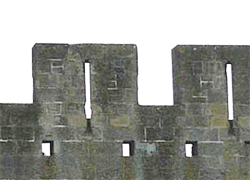
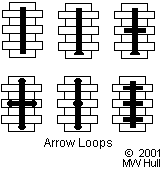
Arrowloops were typically wider on the inside of the wall and narrower on the outside.
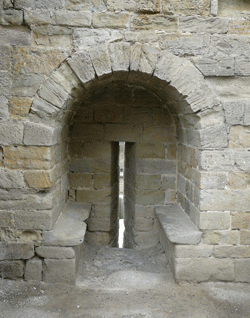
Internal view of arrowloop.
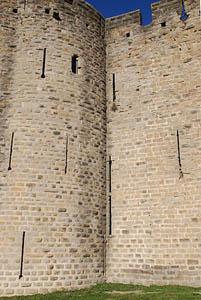
External View of arrowloops.
Labels:
arrowloops,
castle defense,
crenellations,
Medieval Studies 2012-13,
merlons,
parts of a castle
Wednesday, October 31, 2012
Parts of a Castle: The Gatehouse
This is a picture from inside the gatehouse in Leeds Castle, Kent, England.
This is a Norman castle gatehouse in Carmarthen, South West Wales. It dates to about 1409.
Wednesday, October 24, 2012
Castles: Medieval War Machines!
This is a picture of Harlech Castle in Wales.
It was built by King Edward I between 1282 and 1289. Image from Wikipedia
Here is the historical scenario for our castle mapping and building project:
The year is 1282. King Edward I of England has defeated the last Welsch governing family, Prince Llywelyn ap Gruffydd and his brother Dafydd...their last rebellion leading to their eventual defeat and death. King Edward now plans to annex all of Wales and build castles throughout the country to protect his new land. English soldiers will be garrisoned in the castles, and the towns will be settled by English colonists. King Edward's head architect, Master James St. George, has given you the responsibility of planning and building a castle for King Edward. This castle is to be located on Cardigan Bay on the west side of Wales. Where will you choose to build your castle, and why there? Be prepared to defend your overall building plan.
Here is the link to the web site where you can watch
the last three parts of the castle video we watched this week:
http://thehelpfulartteacher.blogspot.com/2012/02/medieval-castles.html
Labels:
castle mapping and building project,
castles,
Exit Ticket #4,
Harlech Castle floor plan,
Medieval Studies 2012-13
Thursday, October 18, 2012
Can a quilt made in the 21st century be a primary source?
Here is an interview with the artist of the quilt called Blue Men. Read it carefully. Then think about whether this quilt is a primary source that tells us about a tribe of people called the Tuaregs.
Interview for Quilt Alliance Nov 11, 2001JoAnn Popisil interviewing artist Hollis Chatelain
http://www.allianceforamericanquilts.org/qsos/interview.php?kid=14-31-363“JP: Who inspired you, as
far as this quilt? The friends that you talked about.
”“HC: It especially started
when I lived in Burkina Faso. There are a lot of Tuaregs. The Tuaregs are a
tribe that is nomadic. They cross the desert on their camels, on their
caravans, and they traditionally carry the goods from north Africa to black
Africa. They're really wonderful people. I was very intrigued by them. The men
wear indigo blue turbans to protect themselves from the sun and the sand. The
indigo, the blue, actually tints their skin blue. That's why this is called
"Blue Men" and why it's painted in blue dyes. When I lived in Burkina
Faso these Tuaregs used to come to the house. These are Tuareg earrings that
I'm wearing right now. They make leather boxes, and silver jewelry. I learned a
lot from those people. Once they realize that you'll buy things, then they're
there all the time, and they want you to sell their handicrafts for them,
because they figure you know more people that have money. I've spent thousands
of hours with these people. I learned to drink Tuareg tea with them, and they
have a wonderful sense of humor. Everywhere that I lived in the Sahel region,
which is the sub-Saharan area in West Africa, there were Tuaregs. I became
friends with them. Never the women, always the men. The Tuaregs would come into
the city to sell their handicrafts. I became good friends with them, and this
is a tribute to those people.”
Friday, October 12, 2012
The Bayeux Tapestry & the The Battle of Hastings
October 14, 1066 is know as a pivotal year in medieval history as an English King dies and leaves a power vacuum that draws in three powerful claimants: a Viking from Norway, a French Norman, and and English Saxon. When English King Edward dies, Englishman Harold Godwinson is endorsed by the Witan, a royal council of advisors, to become the next King. Frenchman William, Duke of Normandy, says the throne was promised to him by the former King Edward, and starts to pull an army together to fight for the crown. At the same time, Viking King Harald Hardrada of Norway says the crown belongs to him, and he also gathers an army. Hardrada and his army invade England in the north, and King Harold goes to fight him in a battle at Stamford Bridge. Hardrada is badly defeated. Meanwhile, William of Normandy lands his army in the south of England, and King Harold now travels to meet William to do battle at Hastings. The video below covers this part of the battle. It focuses on battle strategy, weapons, and how the battle ends.
Below: Norman Soldiers on horseback in the Bayeux Tapestry
Historians consider the Bayeux Tapestry a primary source of information about the Battle of Hastings. This artifact is 230 feet long and 20 inches high. How has such an unusual source survived over 900+ years?! Today it is kept in a museum, the Tapisserie de Bayeux in Bayeux, France. Here is a link to the museum that will give you information about how such a rare source is cared for today:
http://www.tapestry-bayeux.com/index.php?id=403
Thursday, October 4, 2012
The Feudalism Thing?!!!
Here is a fun way to review Feudalism and life on a
Medieval Manor! Click on the video below.
Below is your first online participation assignment! Type your name, first and last, in the Name box. Then read the question and type your answer in the box below the question. Finally, click Submit. That's all there is to it!
Subscribe to:
Comments (Atom)



